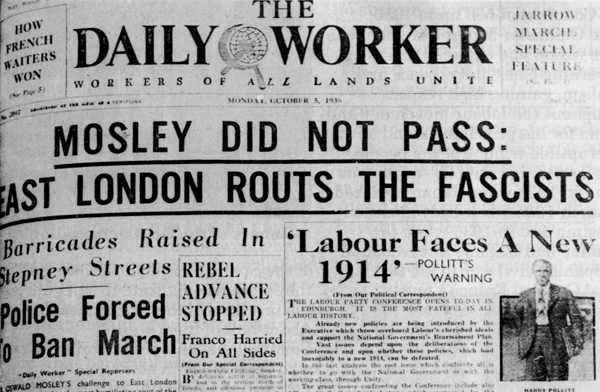
October 4th, 1936 London Police, Jews Do Battle on Cable Street
With their numbers beefed up by communists and Irishmen, the Jews of London gathered to protest Sir 's virulent fascism, but the police were having none of it.
A mural on Cable Street commemorating the violence of 80 years ago when Jews confronted fascists in London's East End. Jo Marshall, Wikimedia Commons
October 4, 1936, was the date of the infamous “Battle of Cable Street,” in which London police battled with counter-demonstrators from the largely Jewish East End who had decided to physically prevent a march through their neighborhood by the British Union of Fascists, led by Sir Oswald Mosley.
Mosley (1896-1980) was the notorious British aristocrat and politician who attracted a large following in his country in the 1930s. He had entered the House of Commons in 1918 as a Conservative, and then moved gradually to the left, serving as an Independent Labor Party and then a Labor MP, before founding the New Party, and losing his seat in the Commons.
Guest of honor: Hitler
During the course of the decade, Mosley, a mesmerizing public speaker who had proposed an economic-recovery plan for Depression-era England that was almost socialist in nature, became enamored of Italian Fascism. He also became obsessed with the idea of Jews as alien to Britain.
When Mosley married for the second time, in 1936 (two days after Cable Street), it was in Berlin, at the home of Joseph Goebbels, with Adolf Hitler as guest of honor.
In short order, the New Party became the British Union of Fascists, which was to change its name several times more before it was outlawed, in 1940. Its frequent marches, in which members dressed in black shirts, similar to Italian Fascists, met with resistance from a wide range of opponents, but widespread tolerance from the police. The result was frequently violent confrontations with counter-demonstrators.
The march planned for Sunday, October 4, 1936, was intended to mark the fourth anniversary of the BUF.
Oswald Mosley, right, and Benito Mussolini, 1936.Wikimedia Commons
As a special provocation, four platforms were set up along the march path – in the East End neighborhoods of Shoreditch, Bethnal Green, Bow and Limehouse – where participants would be addressed by Mosley and others associated with the party.
Anticipating violence, the Jewish Board of Deputies, the community’s umbrella organization advised Jewish Londonders to stay away from the venue. For its part, the government chose not to cancel the march, and it sent some 6,000 police to guarantee that it could proceed.
At the time, an estimated 60,000 Jews lived in this part of London. In their outrage, they were joined by a large number of Irish anti-fascists and socialists and communists.
Communists against fascists
The consequent events came to take on near-mythical proportions, and it’s not easy to pin down the facts.
Estimates of the numbers of counter-demonstrators range from tens of thousands to 100,000 to twice that number. What is clear is that the Communist Party, led by Phil Paritin (later an MP from the party), played a key role in organizing the opposition.
Before the march could even get under way, the police squared off with the counter-demonstrators, who pelted them with rotten fruit and vegetables, and even the contents of chamber pots, from the windows of homes overlooking the route.
Some 150 people, including both police and protesters, were wounded in the violence, and some arrests were made, although most of those arrested only had to pay minimal fines.
With anti-fascist demonstrators blocking the planned march route – and shouting the slogan “No pasaran” (“they shall not pass”), borrowed from the Republicans in the Spanish Civil War – it became known that members of the BUF intended to turn to an alternate route along Cable Street. Counter-demonstrators responded by erecting physical barricades at the intersection of Cable and Christian Streets.
In the end, Police Commissioner Philip Game disallowed the march from taking place, but Mosley simply redirected his supporters to carry out their procession in the opposite direction, to the Embankment.
The British left still fondly recalls the Battle of Cable Street as the day their country said no to fascism. But the truth is that, in the immediate aftermath of that day, the BUF saw a rise in support, even in the East End. Ultimately, though, the party was rejected.
On January 1, 1937, new regulations went into effect that required advance police permission for political demonstrations, and prohibited the wearing of political uniforms in public. In 1940, Mosley’s party was proscribed, and he and many of his supporters were interned, and later sent to house arrest.
No comments:
Post a Comment